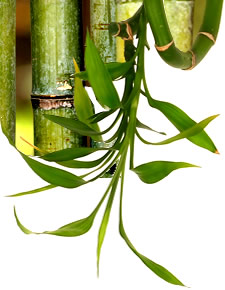

Bamboo Cultivation |
Many bamboos are popular in cultivation as garden plants. In cultivation, care needs to be taken of their potential for invasive behaviour. They spread mainly through their roots and/or rhizomes, which can spread widely underground and send off new culms to break through the surface. There are two patterns for the spreading of bamboo, "clumping" (monopodial) and "running" (sympodial). Clumping bamboo species tend to spread underground slowly. Running bamboo species are highly variable in their tendency to spread; this is related to both the species and the soil and climate conditions. Some can send out runners several metres a year, while others can stay in the same general area for long periods. If neglected, they can be invasive over time and can cause problems by moving into adjacent areas. Once established as a grove, it is difficult to completely remove bamboo without digging up the entire network of underground rhizomes. If bamboo must be removed, an alternative to digging it up is to cut down the culms, and then repeatedly mow down new shoots as they arise, until the root system exhausts its energy supply and dies. The reputation of bamboo as being highly invasive is often exaggerated, and situations where it has taken over large areas is often the result of years of untended or neglected plantings. There are two main ways to prevent the spread of running bamboo into adjacent areas. The first involves surrounding it with a physical barrier, usually a special, high density, plastic roll material made for this purpose; this is placed in a 60-90 cm (2-3 feet) deep ditch around the planting, and angled out at the top to direct the rhizomes to the surface. The second method is rhizome pruning, which involves taking a sharp spade and cutting down into the ground 30 cm (1 foot) all along the perimeter that is to be maintained. The root system is generally very close to the surface, so, if rhizome pruning is done twice a year, it will sever most, if not all, of the new growth. Since the new roots are dependent on older parts of the root system for nourishment, anything beyond the shovel cut will die in the ground and be unable to reestablish itself. Established bamboo will send up shoots that generally grow to their full height in a single season, making it the fastest growing woody plant. Several subtropical bamboo species can grow 30 cm (1 foot) per day, with some species having been documented as growing over 100 cm in one day. For the species most widely cultivated in gardens, 3-5 cm per day is more typical. A newly transplanted bamboo plant can take 1-2 years before it sends up new shoots (culms) and will have many seasons of "sizing up" before new shoots achieve the maximum potential height for that species. |
© Copyright yayixm.com All rights reserved. Unauthorized duplication in part or whole strictly prohibited by international copyright law. |
|
|